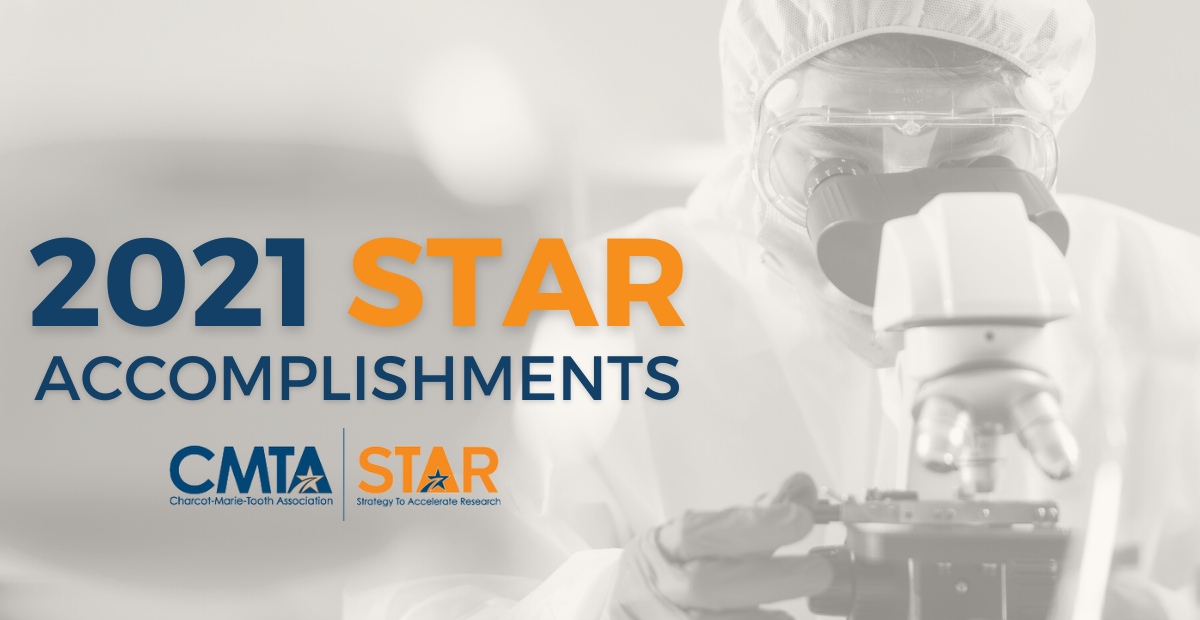
With our community’s help, the CMTA has invested over $17.5 million in CMTA-STAR research since 2008, making us the largest charitable funder of CMT research globally. Through the support of you, our community, the CMTA is proud to share some of the most exciting milestones from 2021:
Although there are more than 100 different genes that cause CMT, there are some common symptoms that affect people living with CMT such as axon degeneration, muscle loss, and more. Part of the CMTA’s strategy is to look at therapeutic approaches that could potentially help several or many different types of CMT.
GENE THERAPY: Developing Gene Therapy to Treat CMT across multiple subtypes
We have recruited the top leaders in Gene Therapy to work on CMT, including: Steven Gray, Scott Harper, Kleopas Kleopa, Anthony Brown, Kathrin Mayer, and Jim Wilson
- Initiatives in: CMT1X, CMT2A, CMT1A, CMT2E, CMT4C, CMT4A, and others in process
- Progress of CMT1X gene therapy initiative by Dr. Kleopas Kleopa
- Genome Editing/CRISPR Cas9 partnership with Conklin/Judge on CMT2E, CMT2A, CMT2F (this funding drew additional support from the NIH)
- Gene Therapy collaboration with Jim Wilson, U Penn & Passage Bio for CMT2A, CMT2E
AXON DEGENERATION: Harnessing New Pathways to Stabilize Axons in most types of CMT
Initiatives in CMT1X, CMT2D, CMT2S, 2E, CMT1B and others in process:
- Approval of the CMTA Board for funding of Axon Degeneration targeting testing in CMT1X
- Robert Burgess, PhD, of Jackson Laboratory is in progress testing axon-sparing strategies involving inhibition of SARM1 for CMT2D, 2S, 2E and CMT1B
Biomarkers: Enabling Clinical Trials in CMT to make them fast & effective
(Biomarkers are used to see how well the body responds to a treatment for a disease)
Initiatives in CMT1A, CMT1X, CMT2A, CMT1B and others in process:
- INC progress in developing muscle MRI and blood sample measurements of neurofilaments
- National Institute of Heath pilot support and CMTA support of skin and blood biomarkers. Sanofi is also supporting the pilot.
- New biomarker paper in collaboration with Sanofi, wearable initiative for CMT 1A.
- Funding of new major Biomarker initiatives for CMT1B and CMT1X and CMT2A.
Drug Development Efforts
Initiatives in CMT1A, CMT1X, CMT2A, CMT1B, CMT4B1, 2D, SORD and others in process:
- Funding of new small molecule projects in 1A last year
- Heightened interest from ASO/RNAi (suppression of gene expression) companies/Academic Group
- New human stem cell approach for CMT1A was funded
- Eight active testing alliances just in 2021 alone
- Funding of three new small molecule approaches for 1X and 1B
- New therapeutic target for CMT2D
- Funded CMT 4B1 research project. Lead investigators: Dr. Alessandra Bolino and Dr. Davide Pareyson
- Phase 2/3 for SORD gene deficiency (S. Zuchner and INC collaborations with Applied Therapeutics)
New STAR Alliance Partners
- ToolGen Biotechnology: Gene Therapies for CMT1A
- Addex Therapeutics for 1A
- APPLIED Therapeutics for SORD
- TAYSHA Gene Therapies for 4A & GAN
- And, we are working on half a dozen other partnerships that are not publicly disclosed yet.
Although we have made many strides, the CMTA will not stop until we discover a cure for CMT and prevent it from affecting future generations. That’s why we ask…if you or someone you know would like to join the efforts of the CMTA in the fight against CMT, contact Jeana Sweeney at jeana@cmtausa.org





